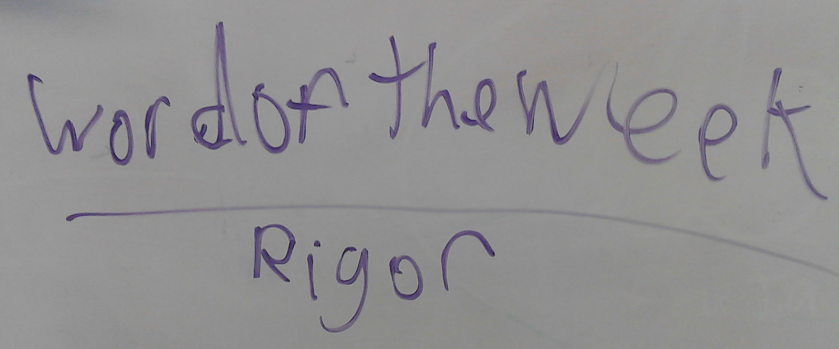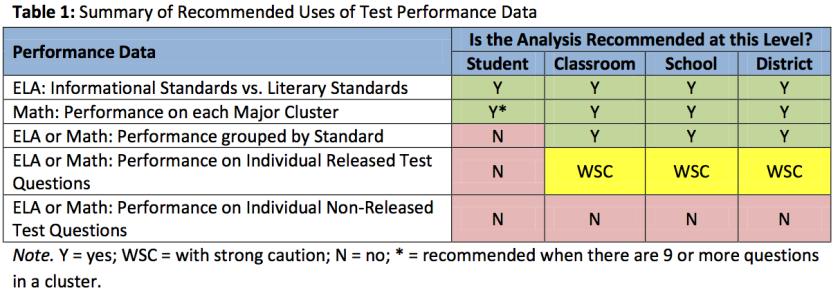Before finalizing a purchase, stock investors conduct what is known as due diligence. They evaluate a company’s products and services against its competitors, study its balance sheet, and look at various charts and ratios to decide if it is an investment worthy of their hard-earned dollars. Not necessarily so for teachers and principals in public education. Instead, policy makers in concert with experts at all levels, conduct the due diligence to write regulations that educators and administrators are then required to follow. In the recent case of the Common Core State Standards, Data Driven Instruction, and Evidence-Based Observations through Race to the Top, that has been a good thing (not so sure about tying teacher and principal performance to student state assessment results, however). The really good news is all stakeholders are working hard to implement the change, even if they weren’t privy to the due diligence work. One only needs to spend time with P-20 educators to see the hard work happening across the state.
Fortunately for me, I get to see great educators and leaders at work frequently in my job, and last week was particularly favorable for such observations.
Tuesday, AM: High School Presentation on Understanding by Design and Lesson Planning using Backwards Design.
Tuesday, PM: SUNY Plattsburgh at Queensbury Seminar Series for Student Teachers on Common Core Instructional Shifts in Literacy
Wednesday, Full Day: edTPA in New York Implementation Conference
Thursday, AM: Principals as Instructional Leaders Seminar Series (SUNY Plattsburgh at Queensbury and WSWHE BOCES Partnership Project)
Thursday, PM: New York Association of Colleges for Teacher Education Reception and Dinner
Friday, AM: Teachers as Instructional Leaders Seminar Series (SUNY Plattsburgh at Queensbury and WSWHE BOCES Partnership Project)
Granted, I wear rose-colored glasses, but the events of this past work week clearly show significant progress in our efforts to raise student achievement. On Monday, I visited a small rural high school in upstate New York and was greeted by an audience of teachers in black t-shirts sporting a Wordle design celebrating their roles as teachers. Their solidarity spoke volumes of the dedication to each other and the children they teach, and our review of UBD led to a spirited discussion on daily lesson planning and student achievement. The teachers greatest concern was writing detailed lesson plans while learning and implementing new curriculum modules and data driven instruction. There is plenty on their proverbial plates. Later that afternoon, I met with 25 student teachers and field supervisors to discuss and model some of the Common Core Instructional Shifts for Literacy. We covered each shift, but practiced text-based answers, academic vocabulary, and building knowledge in the disciplines. Ending the day with young, ambitious future teachers was very nice indeed.
Lest we forget the stressors on the higher ed community, on Wednesday I joined 250 other university and college professors and administrators to learn how best to roll out the edTPA. As we know, future teachers will be required to pass more rigorous exams and complete performance assessments that ask for descriptive, analytic, and reflective thinking and writing on their videotaped lessons. The edTPA demonstrates the value of assessing teachers’ capacities to thoughtfully process their pedagogy against standards of effective teaching. The complexities of rolling out edTPA can not be understated. However, at the edTPA in New York Implementation Conference, my colleagues and I got to see first hand the success stories of early edTPA pilots in colleges and universities spanning the state. It’s working! It’s hard, and it’s messy. However, if you are a fan of authentic, clinically rich self-assessments, then you do what’s necessary to make edTPA work. Another great day.
On Thursday, SUNY Plattsburgh at Queensbury launched the Principals as Instructional Leaders Seminar Series in partnership with WSWHE BOCES. 17 school administrators showed up for the first of a yearlong series of seminars and group research studies that focus on developing instructional leadership skills. Despite their frenetic schedules, these busy school administrators joined together to seek strategies and supports as instructional leaders, and we’re hopeful the content of our seminars and the research each group will conduct around data-driven instruction, common core instructional shifts and standards, and cultivating teacher leadership will meet their needs. Most importantly, we expect the seminars will provide opportunity for sharing ideas, asking questions, problem solving, and networking that otherwise would be unavailable to busy school administrators. Later that evening, I joined other invited members of the Professional Standards and Practices Board for a NYACTE Reception and Dinner, highlighted with Presentation of the New York State Teacher of the Year Award to Ashli Skura Dreher. The evening ended with an uplifting presentation by Ashli on her deeply held and success-proven convictions that all students will learn. Another great ending.
Friday brought together a small group of seven teachers chosen by their superintendents to participate in the SUNY Plattsburgh at Queensbury Teachers as Instructional Leaders Seminar Series in partnership with WSWHE BOCES. The teachers began arriving at noon, though we weren’t officially scheduled to start till 12:30. What energy these folks have! As with the principals who participated in Thursdays seminar, these folks signed up for the series in spite of their workloads and lack of time. Most interestingly, when asked what their greatest fear was as instructional leaders, their concern was that the Common Core Standards would change. It wasn’t things like, “I’m worried about credibility from my colleagues,” or “I don’t know if I have the skills and understandings to be an instructional leader.” Instead, they simply hope there are no more changes. They want to get Common Core, DDI, and Evidence Based Observations right! Hopefully, this seminar series will help them realize their goals. And so ended a very busy, exciting, affirming week.
P-20 educators understand all too well the “churning waters” analogy as the weight of omnipresent forces impact teachers, principals, teacher assistants, superintendents, higher ed faculty, deans of education, student teachers, and most importantly, our children. Despite the chaotic nature of reform and the fact that few were invited to do the due diligence and “sign up” for the changes, most are committed to the Common Core State Standards and concomitant instructional shifts, data-driven instruction, and evidence-based observations. However, most are also frantically clawing to keep their heads above water as they grapple to adapt to the new and seemingly ever-changing landscape. And they don’t want to “Wait five years till something new is in place.” To my P-20 colleagues, I say “Hang on.” “Don’t let go.” It’s extremely challenging, and at times imperfect, work. Still, steady progress is being made which will ultimately best serve our students and this great nation.

